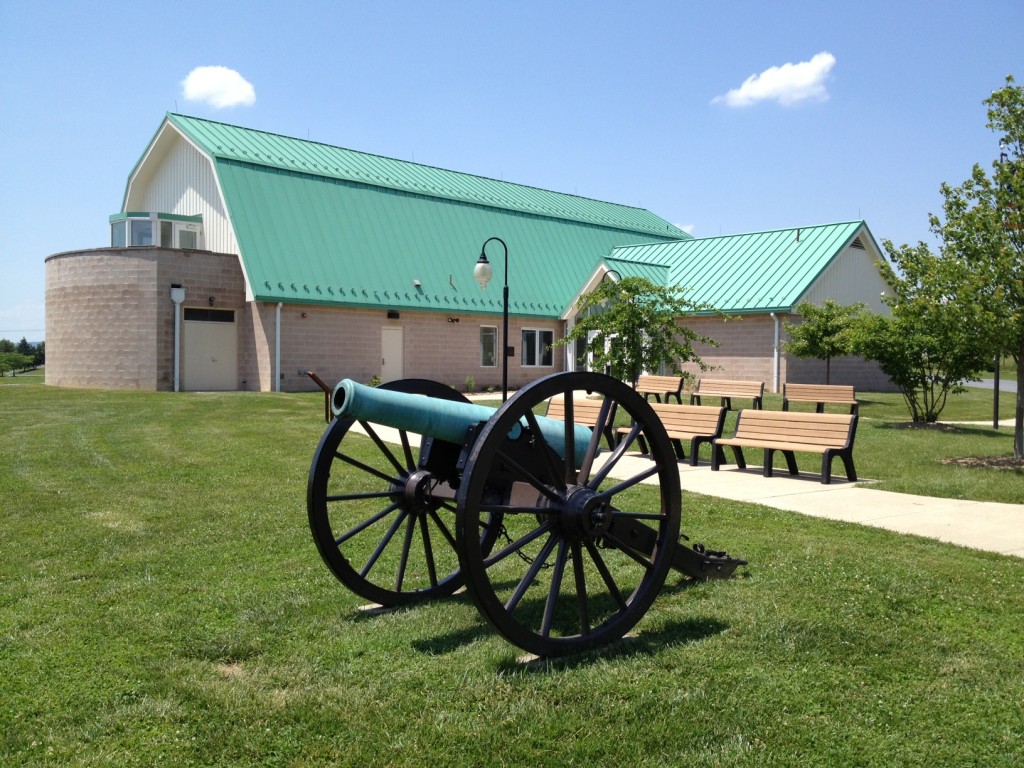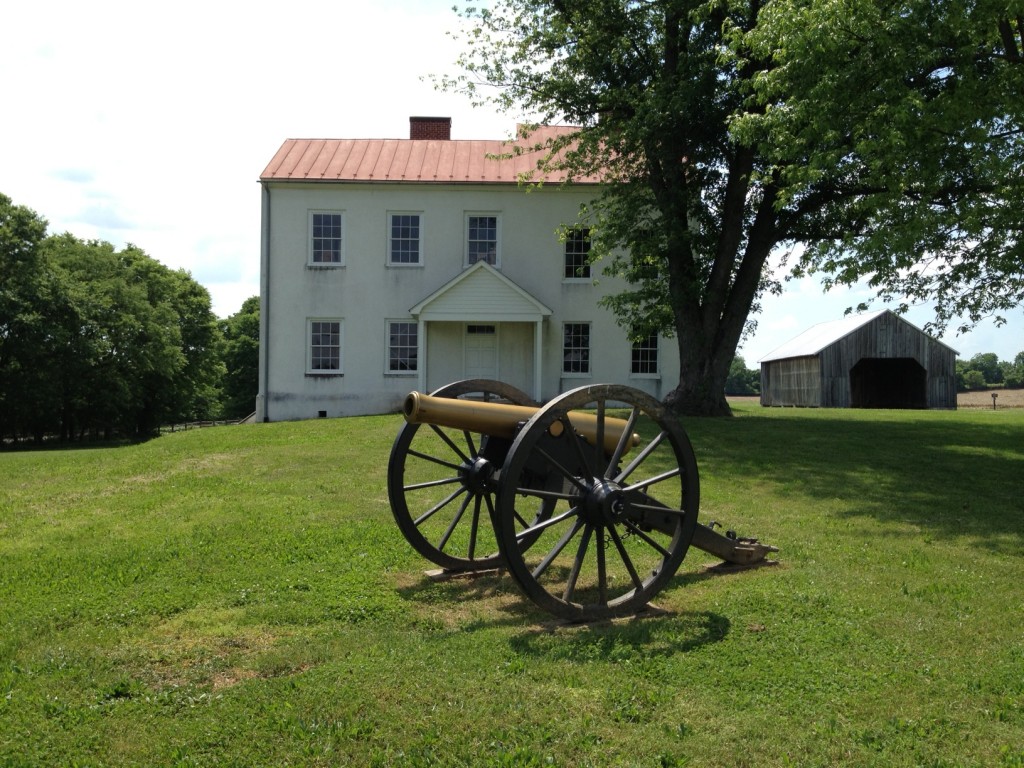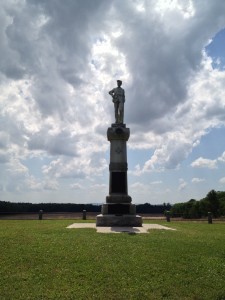Monocacy Visit
Earlier this week, a friend sent me a photo that she took at Monocacy. She knows that I’m interested in Civil War battlefields, and that I have a collection of photos that my friends and I have taken over the years on my work computer that I use when my screen is locked.
It got me thinking though – I’ve never been to Monocacy. I go to Gettysburg constantly. I’ve been to Antietam and Manassas a few times. I’ve even started to branch out to the Fredericksburg / Spotsylvania battlefields. But I’ve never been to Monocacy, and it’s closer to my house than any of those other fields. Since my wife was working this weekend, and I’d have to watch John anyway, I figured that we might as well have an adventure.
I wanted to do my homework first. I went looking for information about the battle in my “new” Time-Life Civil War books. Strategically, I thought the Battle of Monocacy was part of the Overland Campaign, but there was no mention of Monocacy in the book that covers it. No mention in the book about the Petersburg siege either. It wasn’t until I checked the book about the Shenandoah Valley that I found info. While Early did travel to Maryland via the valley, I don’t think I’d consider his move a part of those campaigns. Regardless, there was a decent overview of the action, and it gave enough context that I wouldn’t be lost when I got to the field.
The basics are these: The Confederate Army of Northern Virginia has been bottled up in the defenses of Petersburg, VA following Grant’s horribly bloody Overland Campaign. In an attempt to relieve some of the pressure of the siege, Lee sends Lt. Gen. Jubal Early with 15,000 men, north to threaten Washington, DC. Since the capital’s defenses had been more-or-less cleared-out to strengthen Grant’s army, Early didn’t expect much resistance. Major Gen. Lew Wallace, commanding the Middle Department, called for help from all quarters. He was able to pull together about 6,600 troops from militia units, emergency volunteers, and even the Washington defenses, and set out toward Frederick hoping to meet the advancing Confederates. Wallace knew he didn’t have much of a chance to defeat Early’s overwhelming number of battle-hardened troops, but he hoped to do exactly what he ended up doing – delay Early’s advance long enough for the reinforcements that Grant was sending to arrive in the capital.
Armed with my basic understanding, I packed John up this morning and got on the road west to Frederick after lunch. It took less than 45 minutes to get to the visitor center.
Now this was a pretty small battle by Civil War standards – only about 20,000 troops in total were engaged, and there were less than 25 cannons present between the two armies, so I went into this experience not expecting any artillery nerdery. My arrival at the visitor center got my hopes up though:

Between the parking lot and the building itself, there’s a real, live Napoleon, and it’s a Revere. The muzzle markings are in fine shape and are as follows:
- Manufacturer – Revere Copper Co.
- Year Built – 1862
- Serial Number – 46
- Weight – 1231 lbs
- Inspector – T. J. R.
My source shows this weapon as being held by the Antietam National Battlefield a few miles down the road, so this piece must have been recently transferred. That happens from time to time. According to the Register of Inspections, this gun was accepted into service on May 20, 1862, so not only would it have been on the field in time for Gettysburg, but for Antietam, too – which is probably why they were the owners of the piece at one time. Like the other Reveres, it has the ornate “U.S.” acceptance mark on the top of the barrel between the trunnions. This was fun (and unexpected) to see.
The visitor center is on the small side – it’s comparable in size to Chancellorsville’s. There’s an information desk and gift shop on the main floor, and museum exhibits upstairs. There’s more flashy interactive stuff there than actual artifacts, but it’s very well put-together. The whole building seems very new, although I’m not really sure when it was built.
I got my park map, and started out on the auto tour. One of the other nice things that the park management has put together is a downloadable audio component to complement the tour – it’s also sold as a CD in the visitor center for less than $3. Having that audio really made for a nice experience. Each of the 5 tour stops has about a 5 minute clip associated with it. Combined with well-produced wayside markers at each stop, and the fact that the battle only lasted for 1 day and didn’t have too many moving pieces, you can easily get a good understanding of what happened here back in 1864.
I had to do an artillery-related double-take at tour stop 1, though:

From a distance, I saw a bronze-colored Napoleon. I’ve never seen this on a battlefield before (outside of a gun brought by re-enactors). This is what the guns would have actually looked like during the war – the familiar greenish patina on the bronze weapons is what happens to copper when it “rusts”. Was this an extremely well-kept Napoleon?
Sadly, no. On closer inspection, it was obvious that this was an iron weapon that had been painted a bronze color – there were areas on the gun where the paint had chipped and you could see black (or even rust) underneath. There are no markings on the trunnions, rimbases, or muzzle. These are clearly reproduction guns meant only for display. While that’s disappointing, it’s nice to see a gun presented to the public on a battlefield, looking the way it would have looked at the battle. I’m a little torn on this.
I saw one other reproduction gun like this one on the Worthington Farm (stop 3 on the tour), and no other weapons anywhere on the field. That’s a pretty accurate portrayal of the artillery at this battle so far as I can tell.

It’s a similar situation for monuments. While explanatory waysides were plentiful, I counted only 5 commemorative monuments. One of these – and certainly the grandest one – was a monument to the 14th New Jersey Infantry, which became known as the “Monocacy Regiment” because it had served in this area early in the war defending the railroads, and then returned after a stint with Grant in the Overland Campaign to defend it once again. While I haven’t established a full service history for him yet, I’ve known that a distant cousin, John B. Skillman, served with the 14th NJ at some point during the war. Since it would be a family connection to this battle, and since my infant son is named John, too, this may be one of those things that I need to research further.
Other monuments include one placed by the United Daughters of the Confederacy next to a more descriptive one placed by the State of Maryland. There are also two other unit monuments: one remembering the 87th Pennsylvania, and another across the road for the 10th Vermont. None of these is easy to visit because of parking challenges, though.
There are a few walking trails on the property, and from what I can tell on the maps and from looking at the ground in person, they look like they’d be nice. Several of them go right down to the Monocacy river. The scenery is peaceful, and there’s plenty of interesting old farm buildings, too. It was oppressively hot today, and I didn’t have a good way of carrying John with me, so I didn’t attempt to walk them myself.
All-in-all, I’m glad I went to see the field. To my mind, it’s a relatively minor and simplistic engagement tactically, but it does end up buying time to bolster the defenses of Washington, DC – stifling any chance that the Confederates had of creating serious political problems for Lincoln right before the 1864 election. In this light, it is strategically important to the war, and a strategic Union victory.
It’s worth taking a couple hours to pay tribute to the men who fought here and learn a little about this part of our history.
1 thought on “Monocacy Visit”